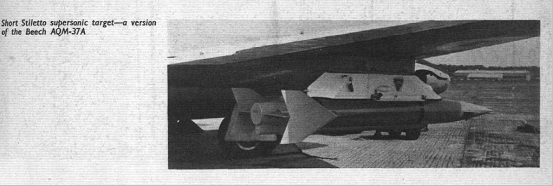
A supersonic target drone whose possible involvement in a mystery airliner crash four decades ago was discounted, may actually have been in service, we can reveal March 24th this year marks
A supersonic target drone whose possible involvement in a mystery airliner crash four decades ago was discounted, may actually have been in service, we can reveal
March 24th this year marks the forty-first anniversary of the crash of Aer Lingus Viscount Flight EI-712 with the loss of all 61 people on board.
The crash occurred near the Tuskar Rock off, Co Wexford, and the proximity of the crash site to the British military missile test site at Aberporth for many years led to concerns of possible military involvement in the inexplicable and sudden accident.
An initial enquiry just after the accident pointedly did not rule out collision with a military aircraft, drone or missile from Aberporth. However, after the Irish government set up a definitive review by independent experts ten years ago this scenario was rejected.
The independent enquiry was dismissive of various theories including suggestions from the Celtic League that debris from a Shorts SD3 STILETTO target drone (Modified Beech AQM - 37A supersonic missile targets) found near the crash site some years later could have been linked to the crash. (See Ref 1 below).
We pointed out that although the MOD and Shorts insisted the SD3 STILETTO test programme was not underway until some two months after the crash that a Canberra aircraft (serial number WE146) was modified to launch the drone was in service in 1967.(Ref 2 below).
What we could not dispute until now was the MOD assertion, accepted by the independent enquiry, that the SD3 STILETTO was not tested until July 1968 (some three months after the crash).
However, we can now reveal that the influential aeronautical journal, Flight, published on 9 February 1967 over a year before the Aer Lingus crash contains the following statement:
\"MACH THREE TARGET DRONES will be in service at the MOA missile development range at Aberporth later this year. Britain becomes the first oversea customer for the Beech AQM-37A supersonic missile target\"
This clearly indicates that the anticipated entry into service was months before the fateful day of the Aer Lingus crash.
There is one other incontrovertible fact and that is that RAF and Civil staff from Shorts flew to Llanbedr in an RAF Anson communications aircraft (the airfield from which drones used at Aberporth were launched two days after the Aer Lingus crash). What is also not in contention is that the visit was in relation to the SD3 STILETTO programme.
The new information does not of course prove that the Aer Lingus disaster was caused by a collision with an SD3 STILETTO (or any other drone). However it does raise questions over the veracity of the so-called expert enquiry.
There is no doubt that a collision with something as large and powerful as the SD3 STILETTO would have been fatal to the Aer Lingus airliner. In addition the markings of the so-called mystery aircraft seen in the area just after the crash would match the markings of the modified Canberra launch aircraft.
It seems that unanswered questions continue to surround the mysterious disaster of Flight EI-712.
Ref. 1 Air Accident Investigation Report (Published 2002) section 5.3.2.1.2:
\"The STILETTO is not taken into consideration since its first flight, in an early prototype configuration, took place in July 1968 (refer Annex B.b Item 2.3).\"
Ref. 2 Shorts Aircraft since 1900 Published 1967 Page 490
In 1967 a Canberra PR3 (WE146) was adapted as a launch vehicle for the American built beech AQM -37A supersonic target drone modified by Shorts for British use.
Related article on Celtic News at:
http://groups.yahoo.com/group/celtic_league/message/2494J B Moffatt Director of Information Celtic League 09/03/09

Commentaires (0)
Aucun commentaire pour le moment. Soyez le premier à réagir !